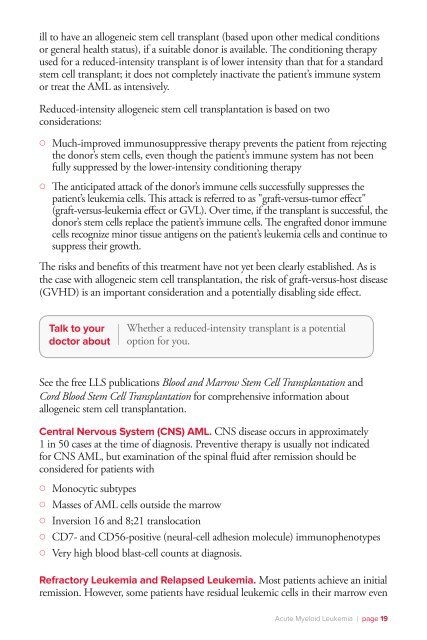Acute Myeloid Leukemia - The Leukemia & Lymphoma Society
Acute Myeloid Leukemia - The Leukemia & Lymphoma Society
Acute Myeloid Leukemia - The Leukemia & Lymphoma Society
- No tags were found...
Create successful ePaper yourself
Turn your PDF publications into a flip-book with our unique Google optimized e-Paper software.
ill to have an allogeneic stem cell transplant (based upon other medical conditionsor general health status), if a suitable donor is available. <strong>The</strong> conditioning therapyused for a reduced-intensity transplant is of lower intensity than that for a standardstem cell transplant; it does not completely inactivate the patient’s immune systemor treat the AML as intensively.Reduced-intensity allogeneic stem cell transplantation is based on twoconsiderations:◦{Much-improved immunosuppressive therapy prevents the patient from rejectingthe donor’s stem cells, even though the patient’s immune system has not beenfully suppressed by the lower-intensity conditioning therapy◦{<strong>The</strong> anticipated attack of the donor’s immune cells successfully suppresses thepatient’s leukemia cells. This attack is referred to as "graft-versus-tumor effect"(graft-versus-leukemia effect or GVL). Over time, if the transplant is successful, thedonor’s stem cells replace the patient’s immune cells. <strong>The</strong> engrafted donor immunecells recognize minor tissue antigens on the patient’s leukemia cells and continue tosuppress their growth.<strong>The</strong> risks and benefits of this treatment have not yet been clearly established. As isthe case with allogeneic stem cell transplantation, the risk of graft-versus-host disease(GVHD) is an important consideration and a potentially disabling side effect.Talk to yourdoctor aboutWhether a reduced-intensity transplant is a potentialoption for you.See the free LLS publications Blood and Marrow Stem Cell Transplantation andCord Blood Stem Cell Transplantation for comprehensive information aboutallogeneic stem cell transplantation.Central Nervous System (CNS) AML. CNS disease occurs in approximately1 in 50 cases at the time of diagnosis. Preventive therapy is usually not indicatedfor CNS AML, but examination of the spinal fluid after remission should beconsidered for patients with◦{Monocytic subtypes◦{Masses of AML cells outside the marrow◦{Inversion 16 and 8;21 translocation◦{CD7- and CD56-positive (neural-cell adhesion molecule) immunophenotypes◦{Very high blood blast-cell counts at diagnosis.Refractory <strong>Leukemia</strong> and Relapsed <strong>Leukemia</strong>. Most patients achieve an initialremission. However, some patients have residual leukemic cells in their marrow even<strong>Acute</strong> <strong>Myeloid</strong> <strong>Leukemia</strong> I page 19
















